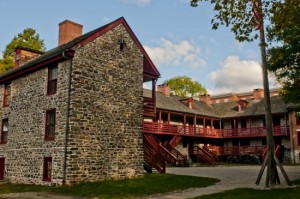 On the night of December 25, 1776, General George Washington led 2,400 troops of the Continental Army in a perilous crossing of the icy Delaware River. Beset by freezing rain, they marched nine miles to Trenton, and delivered a stunning surprise attack on the Hessian garrison early the next morning.
On the night of December 25, 1776, General George Washington led 2,400 troops of the Continental Army in a perilous crossing of the icy Delaware River. Beset by freezing rain, they marched nine miles to Trenton, and delivered a stunning surprise attack on the Hessian garrison early the next morning.
Washington’s forces, by dividing into two wings, confused the Hessian garrison of 1,400 men at Trenton into believing themselves encircled. Some 22 Hessian soldiers and officers were killed, including Colonel Johann Rall, their commander; 84 were wounded, and 886 were taken prisoner. This decisive victory at the first Battle of Trenton revitalized the American cause.
After ferrying their Hessian prisoners across the Delaware to Pennsylvania on December 26, Washington’s troops returned to New Jersey to engage the British at Trenton once again on January 2, 1777. Fighting along the Assunpink Creek ended at dusk. During the night, Washington led his troops along a back route to Princeton, where he attacked General Cornwallis’ rear guard on the morning of January 3, 1777. While the second Battle of Trenton (also known as the Battle of the Assunpink) had no military outcome, it enabled another American victory, at Princeton. In the ten days succeeding Christmas, Washington had engaged the enemy in three battles and by winning two had restored belief in the possibility of ultimate victory.
The Old Barracks Museum is a prime spot to begin your Ten Crucial Days tour in Trenton. In December 1776, the Barracks were occupied by British and Hessian troops. After the Battles of Trenton and Princeton, the Barracks were then occupied by the revolutionaries and used as a hospital. Every winter, the Old Barracks is central to Patriots Week celebrations and the Battles of Trenton reenactments.
Experience these pivotal events via smartphone or home computer through our Ten Crucial Days audio tour! Download the GPS-triggered mobile tour here or view online.
Other Trenton sites associated with the battles, but not regularly open to the public, include:
The 1739 Friends Meeting House (Hanover and Montgomery Streets) was occupied by British Dragoons in December 1776. George Clymer, a Pennsylvania signer of the Declaration of Independence, is interred in the burial ground.
Saint Michael’s Church (North Warren Street at Perry): The congregation of this 1747 “English Church” was split between Loyalists and Patriots, causing the suspension of religious services during the war. David Brearly, a New Jersey signer of the Constitution, who later became the state’s first federal judge, is buried in the churchyard.
Buried on the west side of the First Presbyterian Church (120 E. State St.) in unmarked graves are Hessians who died in the First Battle of Trenton, including Colonel Johann Rall. Reverend John Rosbrugh, a casualty of the Second Battle of Trenton, and the first American clergyman to die in battle is buried on the east side.
On January 2, 1777, the small frame 1766 Alexander Douglass House (oft-moved, now at Front and Montgomery Streets) sheltered the Continental Army council of war where the decision was made to make an overnight march to Princeton to attack the British garrison.
Princeton sites associated with the battles during Ten Crucial Days, include:
Princeton Battlefield State Park
- Gen. George Washington had his victory in the field over British regulars.
- Gen. George Washington rallied two routed brigades and brought them into battle and launched a decisive counter attack that swept the British off field.
- Gen. Hugh Mercer was mortally wounded in the first phase of the battle.
- Capt. Alexander Hamilton commanded artillery bombarding Nassau Hall in the final phase of the battle.
- Capt. William Shippen became the first United States Marine killed on a battlefield.
- The battle was the culmination of the Ten Crucial Days Campaign,which occurred between December 25, 1776 to January 3, 1777. The Ten Crucial Days was a remarkable series of engagements and maneuvers that turned the tide of the American fortunes of war that eventually resulted in this nation’s independence from English rule.
The Clarke House served as a field hospital during the battle. This historic sites currently has an exhibit featuring a large variety of original flintlock muskets, fowling guns, and blunderbusses in use during the Revolution. The exhibit also includes period edged weapons, powder horns and artifacts as well as paintings of the battle.
